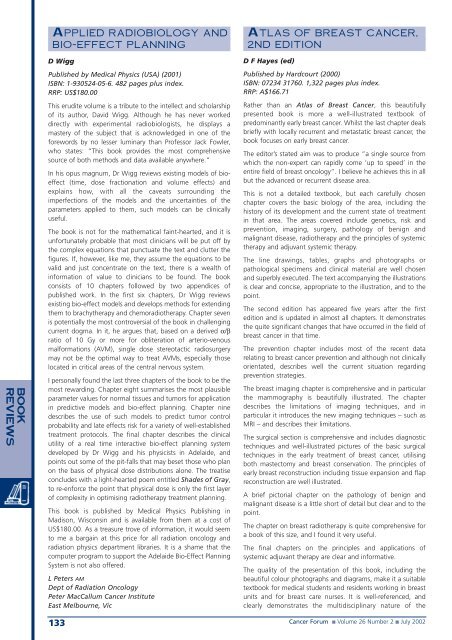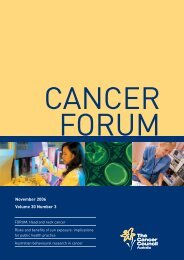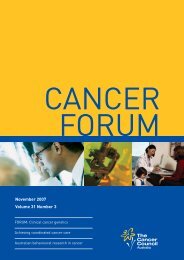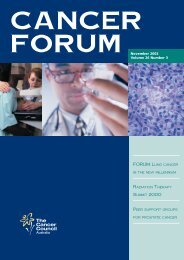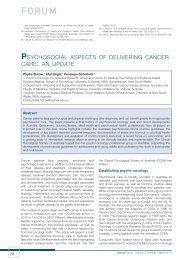Cancer Forum
Cancer Forum
Cancer Forum
- No tags were found...
Create successful ePaper yourself
Turn your PDF publications into a flip-book with our unique Google optimized e-Paper software.
ookreviewsAPPLIED RADIOBIOLOGY ANDBIO-EFFECT PLANNINGD WiggPublished by Medical Physics (USA) (2001)ISBN: 1-930524-05-6. 482 pages plus index.RRP: US$180.00This erudite volume is a tribute to the intellect and scholarshipof its author, David Wigg. Although he has never workeddirectly with experimental radiobiologists, he displays amastery of the subject that is acknowledged in one of theforewords by no lesser luminary than Professor Jack Fowler,who states: “This book provides the most comprehensivesource of both methods and data available anywhere.”In his opus magnum, Dr Wigg reviews existing models of bioeffect(time, dose fractionation and volume effects) andexplains how, with all the caveats surrounding theimperfections of the models and the uncertainties of theparameters applied to them, such models can be clinicallyuseful.The book is not for the mathematical faint-hearted, and it isunfortunately probable that most clinicians will be put off bythe complex equations that punctuate the text and clutter thefigures. If, however, like me, they assume the equations to bevalid and just concentrate on the text, there is a wealth ofinformation of value to clinicians to be found. The bookconsists of 10 chapters followed by two appendices ofpublished work. In the first six chapters, Dr Wigg reviewsexisting bio-effect models and develops methods for extendingthem to brachytherapy and chemoradiotherapy. Chapter sevenis potentially the most controversial of the book in challengingcurrent dogma. In it, he argues that, based on a derived α/βratio of 10 Gy or more for obliteration of arterio-venousmalformations (AVM), single dose stereotactic radiosurgerymay not be the optimal way to treat AVMs, especially thoselocated in critical areas of the central nervous system.I personally found the last three chapters of the book to be themost rewarding. Chapter eight summarises the most plausibleparameter values for normal tissues and tumors for applicationin predictive models and bio-effect planning. Chapter ninedescribes the use of such models to predict tumor controlprobability and late effects risk for a variety of well-establishedtreatment protocols. The final chapter describes the clinicalutility of a real time interactive bio-effect planning systemdeveloped by Dr Wigg and his physicists in Adelaide, andpoints out some of the pit-falls that may beset those who planon the basis of physical dose distributions alone. The treatiseconcludes with a light-hearted poem entitled Shades of Gray,to re-enforce the point that physical dose is only the first layerof complexity in optimising radiotherapy treatment planning.This book is published by Medical Physics Publishing inMadison, Wisconsin and is available from them at a cost ofUS$180.00. As a treasure trove of information, it would seemto me a bargain at this price for all radiation oncology andradiation physics department libraries. It is a shame that thecomputer program to support the Adelaide Bio-Effect PlanningSystem is not also offered.L Peters AMDept of Radiation OncologyPeter MacCallum <strong>Cancer</strong> InstituteEast Melbourne, Vic133ATLAS OF BREAST CANCER,2ND EDITIOND F Hayes (ed)Published by Hardcourt (2000)ISBN: 07234 31760. 1,322 pages plus index.RRP: A$166.71Rather than an Atlas of Breast <strong>Cancer</strong>, this beautifullypresented book is more a well-illustrated textbook ofpredominantly early breast cancer. Whilst the last chapter dealsbriefly with locally recurrent and metastatic breast cancer, thebook focuses on early breast cancer.The editor’s stated aim was to produce “a single source fromwhich the non-expert can rapidly come ‘up to speed’ in theentire field of breast oncology”. I believe he achieves this in allbut the advanced or recurrent disease area.This is not a detailed textbook, but each carefully chosenchapter covers the basic biology of the area, including thehistory of its development and the current state of treatmentin that area. The areas covered include genetics, risk andprevention, imaging, surgery, pathology of benign andmalignant disease, radiotherapy and the principles of systemictherapy and adjuvant systemic therapy.The line drawings, tables, graphs and photographs orpathological specimens and clinical material are well chosenand superbly executed. The text accompanying the illustrationsis clear and concise, appropriate to the illustration, and to thepoint.The second edition has appeared five years after the firstedition and is updated in almost all chapters. It demonstratesthe quite significant changes that have occurred in the field ofbreast cancer in that time.The prevention chapter includes most of the recent datarelating to breast cancer prevention and although not clinicallyorientated, describes well the current situation regardingprevention strategies.The breast imaging chapter is comprehensive and in particularthe mammography is beautifully illustrated. The chapterdescribes the limitations of imaging techniques, and inparticular it introduces the new imaging techniques – such asMRI – and describes their limitations.The surgical section is comprehensive and includes diagnostictechniques and well-illustrated pictures of the basic surgicaltechniques in the early treatment of breast cancer, utilisingboth mastectomy and breast conservation. The principles ofearly breast reconstruction including tissue expansion and flapreconstruction are well illustrated.A brief pictorial chapter on the pathology of benign andmalignant disease is a little short of detail but clear and to thepoint.The chapter on breast radiotherapy is quite comprehensive fora book of this size, and I found it very useful.The final chapters on the principles and applications ofsystemic adjuvant therapy are clear and informative.The quality of the presentation of this book, including thebeautiful colour photographs and diagrams, make it a suitabletextbook for medical students and residents working in breastunits and for breast care nurses. It is well-referenced, andclearly demonstrates the multidisciplinary nature of the<strong>Cancer</strong> <strong>Forum</strong> ■ Volume 26 Number 2 ■ July 2002


